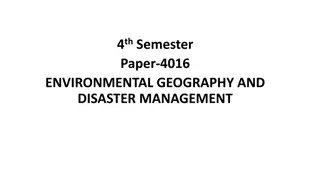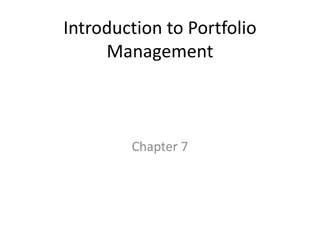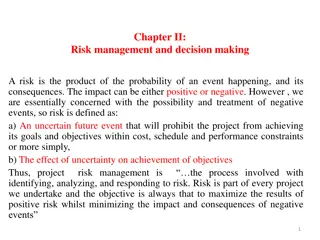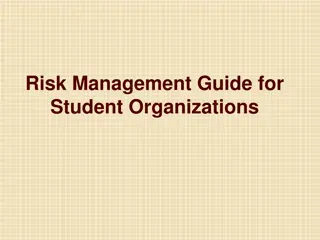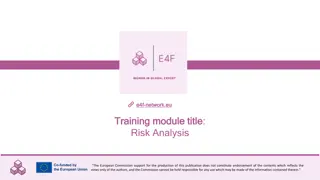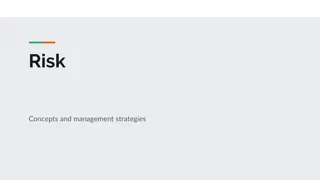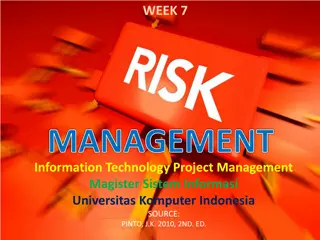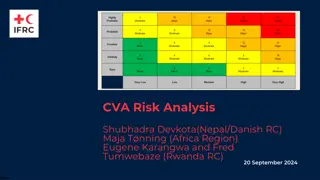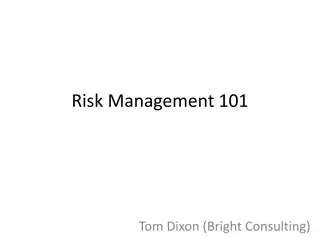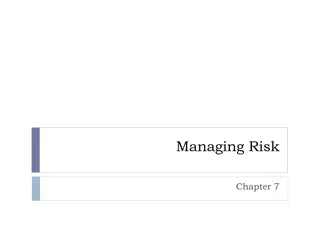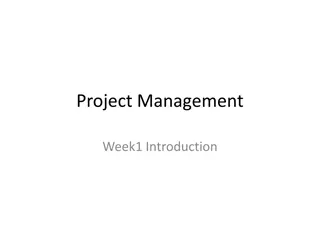Project Risk Management Fundamentals: A Comprehensive Overview
Project risk management involves minimizing potential risks and maximizing opportunities through processes such as risk management planning, risk identification, qualitative and quantitative risk analysis, risk response planning, and risk monitoring and control. Quantitative risk analysis assesses the likelihood and impact of identified risks using mathematical or statistical techniques. Tools and techniques such as Probability/Impact matrixes are used for risk quantification.
Download Presentation

Please find below an Image/Link to download the presentation.
The content on the website is provided AS IS for your information and personal use only. It may not be sold, licensed, or shared on other websites without obtaining consent from the author.If you encounter any issues during the download, it is possible that the publisher has removed the file from their server.
You are allowed to download the files provided on this website for personal or commercial use, subject to the condition that they are used lawfully. All files are the property of their respective owners.
The content on the website is provided AS IS for your information and personal use only. It may not be sold, licensed, or shared on other websites without obtaining consent from the author.
E N D
Presentation Transcript
Chapter VI: Quantitative Risk analysis The goal of project risk management is to minimize potential risks while maximizing potential opportunities. Major processes include Risk management planning: deciding how to approach and plan the risk management activities for the project Risk identification: determining which risks are likely to affect a project and documenting their characteristics Qualitative risk analysis: characterizing and analyzing risks and prioritizing their effects on project objectives Quantitative risk analysis: consequences of risks Risk response planning: taking steps to enhance opportunities and reduce threats to meeting project objectives Risk monitoring and control: monitoring known risks, identifying new risks, reducing risks, and evaluating the effectiveness of risk reduction measuring the probability and 1
Potential Risk Conditions Associated With Each Knowledge Area Knowledge Area Integration Risk Conditions Inadequate planning; poor resource allocation; poor integration management; lack of post-project review Poor definition of scope or work packages; incomplete definition of quality requirements; inadequate scope control Errors in estimating time or resource availability; poor allocation and management of float; early release of competitive products Estimating errors; inadequate productivity, cost, change, or contingency control; poor maintenance, security, purchasing, etc. Scope Time Cost Quality Poor attitude toward quality; substandard design/materials/workmanship; inadequate quality assurance program Poor conflict management; poor project organization and definition of responsibilities; absence of leadership Carelessness in planning or communicating; lack of consultation with key stakeholders Ignoring risk; unclear assignment of risk; poor insurance management Unenforceable conditions or contract clauses; adversarial relations Human Resources Communications Risk Procurement 2
Quantitative Risk Analysis Assess the likelihood and impact of identified risks to determine their magnitude and priority Quantitative approaches to project risk analysis include mathematical or statistical techniques that allow us to model a particular risk situation. At the heart of many of these models is the probability distribution. Probability distributions can be continuous or discrete. 3
Cont 4
Risk quantification tools and techniques include Probability/Impact matrixes The Top 10 Risk Item Tracking technique Expert judgment 5
Sample Probability/Impact Matrix for Qualitative Risk Assessment 6
Chart Showing High-, Medium-, and Low-Risk Technologies 7
Top 10 Risk Item Tracking Top 10 Risk Item Tracking is a tool for maintaining an awareness of risk throughout the life of a project Establish a periodic review of the top 10 project risk items List the current ranking, previous ranking, number of times the risk appears on the list over a period of time, and a summary of progress made in resolving the risk item 8
Example of Top 10 Risk Item Tracking Monthly Ranking Risk Item This Month 1 Last Month 2 Number of Months Risk Resolution Progress Inadequate planning 4 Working on revising the entire project plan Poor definition of scope 2 3 3 Holding meetings with project customer and sponsor to clarify scope Absence of leadership 3 1 2 Just assigned a new project manager to lead the project after old one quit Poor cost estimates 4 4 3 Revising cost estimates Poor time estimates 5 5 3 Revising schedule estimates 9
Expert Judgment Many organizations rely on the intuitive feelings and past experience of experts to help identify potential project risks Experts can categorize risks as high, medium, or low with or without more sophisticated techniques 10
Quantitative risk analysis Often follows qualitative risk analysis, but both can be done together or separately Large, complex project involving leading edge technologies often require extensive quantitative risk analysis Main techniques include Decision tree analysis simulation 11
Decision Trees and Expected Monetary Value (EMV) A decision tree is a diagramming method used to help you select the best course of action in situations in which future outcomes are uncertain EMV is a type of decision tree where you calculate the expected monetary value of a decision based on its risk event probability and monetary value 12
Simulation Simulation uses a representation or model of a system to analyze the expected behavior or performance of the system Monte Carlo analysis simulates a model s outcome many time to provide a statistical distribution of the calculated results To use a Monte Carlo simulation, you must have three estimates (most likely, pessimistic, and optimistic) plus an estimate of the likelihood of the estimate being between the optimistic and most likely values 14
Sample Monte Carlo Simulation Results for Project Schedule 15
Risk Response Planning After identifying and quantifying risk, you must decide how to respond to them Four main strategies: Risk avoidance: eliminating a specific threat or risk, usually by eliminating its causes Risk acceptance: accepting the consequences should a risk occur Risk transference: shifting the consequence of a risk and responsibility for its management to a third party Risk mitigation: reducing the impact of a risk event by reducing the probability of its occurrence 17
General Risk Mitigation Strategies for Technical, Cost, and Schedule Risks 18
Risk Response Control Risk response control involves executing the risk management processes and the risk management plan to respond to risk events Risks must be monitored based on defined milestones and decisions made regarding risks and mitigation strategies Sometimes workarounds or unplanned responses to risk events are needed when there are no contingency plans 19
Cont Various tools exist for monitoring and controlling project risk. These include: Risk Audits A knowledgeable manager or group can be useful for auditing the project team from time to time. The audit should focus on ensuring that the project manager and team have done a good job of identifying and analyzing project risks and on ensuring that proper procedures and processes are in place. Risk audits should be conducted by people outside the project team. Using outsiders provides a fresh perspective; the project team may be too close to the project and miss significant threats or opportunities. 20
Cont Risk Reviews Risk audits should be conducted by individuals outside the project team; but risk reviews can be conducted internally. Throughout the project life cycle, the project stakeholders should hold scheduled, periodic risk reviews. These reviews should be part of each team meeting and part of the project team's learning cycles. Risk Status Reports Similar to risk reviews, a monitoring and control system should provide a formal communication system for monitoring and controlling project risks. 21
Using Software to Assist in Project Risk Management Databases can keep track of risks. Many IT departments have issue tracking databases Spreadsheets can aid in tracking and quantifying risks More sophisticated risk management software, such as Monte Carlo simulation tools, help in analyzing project risks 22
Results of Good Project Risk Management Unlike crisis management, good project risk management often goes unnoticed Well-run projects appear to be almost effortless, but a lot of work goes into running a project well Project managers should strive to make their jobs look easy to reflect the results of well-run projects 23
THREE ELEMENTS OF PROJECT RISK ANALYSIS There are three basic concerns in project management: 1. Schedule. Will the project go over schedule? 2. Cost. Will the project overrun its budget? 3. Performance. Will the output satisfy the goal(s) of the project? So by the definition of risk in the previous chapter each of these elements should be subjected to a risk analysis (preferably quantitative) that will help project managers decide whether the project is in jeopardy of not meeting its commitments and whether or not to take action to mitigate the risk. 24
Cont What is schedule risk? It is the probability that a project will overrun its schedule. Conceptually we would like to see an analysis such as the following nominal graph of schedule risk for an imaginary project: 25
Cont 26
Cont If the deadline for the project is 42 months this analysis indicates that the probability of completing the project in that time is 80%. There is only a 50% chance of completion in 35 months, and we are virtually certain that the project will be completed in 70 months. 27
Cont For cost we would like to see a similar curve, with the difference being that on the x-axis we would have cost at completion rather than months to completion: 28
Cont 29
Cont We expect these curves to be different at different stages of the project; for example during the planning stages both curves might have a less steep slope, indicating that there is considerable uncertainty about the length of the project or its total cost, i.e., there is larger probability of going past 70 months in duration. As the project progresses the curves may shift in either direction as events happen that increase or decrease schedule or costs. And, as the project nears completion, the curve should become steeper as we become more certain about the final completion date and cost. These curves encapsulate what we want in a risk assessment of cost and schedule. 30
Performance Risk Unlike schedule and cost risk analysis, where the methodologies are largely generic across all project types, methods of performance risk analysis tend to be much more tightly tied to subject area. Further, quantifying the relationships between different aspects of performance may be much more difficult. 31
Summary Project risk management is the art and science of identifying, analyzing, and responding to risk throughout the life of a project and in the best interests of meeting project objectives Main processes include: Plan risk management Identify risks Perform qualitative risk analysis Perform quantitative risk analysis Plan risk responses Control risks 32
Cont The project manager working with the project team and project sponsors will ensure that risks are actively identified, analyzed, and managed throughout the life of the project. Risks will be identified as early as possible in the project so as to minimize their impact. The steps for accomplishing this are outlined in the following sections. The <project manager or other designee> will serve as the Risk Manager for this project. RISK IDENTIFICATION Risk identification will involve the project team, appropriate stakeholders, and will include an evaluation of environmental factors, organizational culture and the project management plan including the project scope. Careful attention will be given to the project deliverables, assumptions, constraints, WBS, cost/effort estimates, resource plan, and other key project documents. A Risk Management Log will be generated and updated as needed and will be stored electronically in the project library located. 33
Cont RISK ANALYSIS All risks identified will be assessed to identify the range of possible project outcomes. Qualification will be used to determine which risks are the top risks to pursue and respond to and which risks can be ignored. Qualitative Risk Analysis The probability and impact of occurrence for each identified risk will be assessed by the project manager, with input from the project team using the following approach: Probability High probability of occurrenceGreater than 70% 34
Cont Medium Between 30% and 70% probability of occurrence Low Below 30% probability of occurrence 35
Cont Impact High Risk that has the potential to greatly impact project cost, project schedule or performance Medium Risk that has the potential to slightly impact project cost, project schedule or performance Low Risk that has relatively little impact on cost, schedule or performance 36
Cont Quantitative Risk Analysis Analysis of risk events that have been prioritized using the qualitative risk analysis process and their affect on project activities will be estimated, a numerical rating applied to each risk based on this analysis, and then documented in this section of the risk management plan. RISK RESPONSE PLANNING Each major risk (those falling in the Red & Yellow zones) will be assigned to a project team member for monitoring purposes to ensure that the risk will not fall through the cracks . For each major risk, one of the following approaches will be selected to address it: Avoid eliminate the threat by eliminating the cause Mitigate Identify ways to reduce the probability or the impact of the risk Accept Nothing will be done Transfer Make another party responsible for the risk (buy insurance, outsourcing, etc.) 37
Cont RISK REPORTING The level of risk on a project will be tracked, monitored and reported throughout the project lifecycle. A Top 10 Risk List will be maintained by the project team and will be reported as a component of the project status reporting process for this project. All project change requests will be analyzed for their possible impact to the project risks. Management will be notified of important changes to risk status as a component to the Executive Project Status Report. MONITORING, CONTROLLING, AND 38
Sadden quiz (10%) Make your own summary on what you have learned about 1. Risk management planning 2. Risk identification 3. Qualitative risk analysis 4. Quantitative risk analysis 5. Risk response planning 6. Risk monitoring and control 39
End of the course ! Wish you all the best! 41




